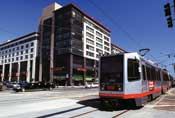Meeting Halfway A Chicago public housing initiative reaches its midpoint. In 2000, the Chicago Housing Authority and HUD signed an agreement to do something unheard of in America’s inner cities—replace and transform blighted public housing with 25,000 new or rehabilitated units mixed with market-rate housing.
Though the program faced challenges and legal complaints, the Chicago agency recently passed the halfway point of its ambitious program. Since the program began, private developers have built or renovated 13,000 units, including 90 percent of the senior sites, and rehabbed 95 percent of the scattered-site units. “Something of this magnitude has never been done before in public housing,” says Terry Peterson, CEO of CHA. “But we always said this was a work in progress. We will take this on a year-by-year basis.”
The private sector is playing a huge role in the Chicago transformation by building and managing new units, as well as providing financial incentives for their employees to move into the mixed-income developments. “The private sector and civic community have really stepped up to support this effort,” Peterson says.
Still, challenges lie ahead. Joseph Williams, president on Granite Development, a Chicago-based developer working with CHA in the project, remains concerned about financial support for the program. The future of Hope VI grants, a critical source of funds, is his biggest concern. “I don’t know where the funding would come from if that [Hope VI] funding was not there,” Williams says.
Slight Slip Multifamily production eases—just barely—in 2004. Between the number of cranes, job sites, and advertisements announcing “New Condominiums Coming Soon!” it’s hard to believe that multifamily housing starts actually decreased in 2004. But they did, albeit by a hair.
According to the U.S. Census Bureau, starts for multifamily structures of five units or more decreased by almost 4 percent, from 315,200 to 303,000 units.
(At the same time, though, building activity among structures of two to four units jumped in 2004. Starts for these buildings increased 26 percent, from 33,500 units in 2003 to 42,300 last year. As a result, combined multifamily production dropped by less than 1 percent in 2004.)
Much of last year’s activity, of course, came from condos, which has been a hot spot for the industry. But things may be cooling off a little. The NAHB, for one, forecasts housing starts for structures of five or more units to stay at 303,000 in 2005.
Condo builders are also watching the market carefully. “We continue to be cautiously optimistic, while making adjustments in our business plan for the possibility of interest rate increases and slowing sales,” says Scott K. Choppin, managing partner for Urban Pacific Builders in Long Beach, Calif., who says downtown is the place to be. “The urban infill market is generally so product-constrained that we see a continuing strong market for well-located, highly amenitized infill transactions.”
